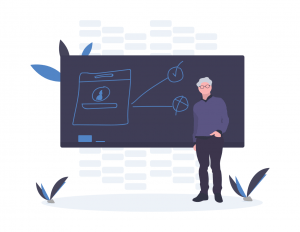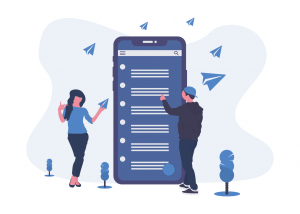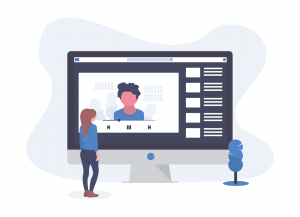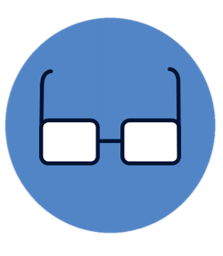A step-by-step guide on How to Make the Best eLearning Course
Secrets shall reveal themselves here today! eLearning industry is at its rise and designing engaging courses, that are interactive and that complete all your learning objectives is challenging. It is not impossible, however. This is the very basic, very simple and easy step-by-step guide to design your next best eLearning course . There is some basic terminology that you will have to get by, but it’s all really easy to understand.

Are you ready to design the Best eLearning Course ?
So, eLearning courses have lots of requirements, and like every project, eLearning designs are created by lots of people overlooking them and making sure the end product is perfect. People involved are eLearning developers, Instructional designers and SMEs (Subject Matter Experts). Pro tip: Hiring the best team makes the dream team!
Step 1: Identify and Define your Goals about Best eLearning Course
First things first, now’s the time to figure out what your best eLearning course is trying to accomplish. To align your clients’ goals with your learning objectives – you need to understand what skills or knowledge your learners want to learn and need to gain. Their demographics need to be considered here and then you will need to think about what they are most looking for. What do they care to know about? It’s all in the in-depth understanding of your customers and audience. After they complete the course, what will your learners be able to do? What skills will they be able to show? What new knowledge will they obtain?
Pro tip: Make the learning objectives magnetic and compelling.
Then define the purpose of this eLearning course. Is it teaching a skill, or helping them take the next step forward, is it something to promote your brand and services? What are you trying to tell? This goes hand in hand with the topic you go with, which is discussed in step 2.

Step 2: Pick a perfect, high demand course topic/idea
Picking the topic of your course is the most crucial task. Once this is decided, it may be possible that you have to redefine your goals. It is all fine, as long as the topic matches the goals and the goals match the learning objectives.
Conducting market research tests to see if the topic you chose even has a demand or not would be a wise step. Strong market demand for a course idea will make it fly. 3 main things to look out for:
- Are people talking about this topic idea?
- Are people asking questions about it?
- Will your course out there help with answering them?
If all these answers are in ‘Yes’ – you have a best-selling course idea.
Make sure you are a) passionate about the topic b) good at teaching about the topic. This will give your course an edge like none other.
Step 3: Gather your Course Content

This is crucial. It is important to get everything right in here. The content needs to be enough; it needs to be right; it needs to be necessary. SMEs are the experts for this part. Having all the information beforehand will make it easier to edit and craft out what content makes it to the final cut.
Make sure you know your audience, and what they want. You can go for interviews and get the feedback that will help majorly. Make surveys and focus groups and send them out to get an in-depth understanding of what the people are looking for. The main objective here should be completing the objectives and expectations of the learners. You want them to be impressed with the content.
There is uncountable and entire volumes worth of information out there, and when that combines with the information we have in our heads or books: in short, there is a LOT. The art of this step is in picking out the information we need to discard. Get your learning outcomes in front, and throw out everything that does not directly relate to them.
Answer your clients’ questions, fill all the gaps that others left behind. What should you gather?
- Texts
- Images
- Videos
- Reference documents
- Webpages
- Recorded Webinars
Here, subject matter experts (SMEs) will help you figure out what should be included and how it’s relevant to the course’s learning objectives.
Step 4: Figure out how to make the content engaging
Adding engaging content is one of the most critical things here. This will either make or break your course. You need good engaging content that will have more and more interaction with the audience. What to add then?
- Integrate questions
- Short quizzes
- Storytelling with lots of interactive content
This will make sure learners aren’t bored and continue to learn until the end. Ask yourself these questions:
- Do I have the right number of videos, readings, activities and audio content?
- Do I have visuals? What type are they?
A balance between all content is necessary. Too many videos will cause cognitive overload, too less will be too dull. The goal here is to make sure that everyone is engaged and they have the optimum learning experience.
Step 5: Outline and Storyboard your content

After getting all the content finalized, you have to fit in either into a storyboard, or any outline you like for the course. It’s important to go in chronological order, it’s the easiest to understand. All you need to figure out is how you will put all that information together.
Create an outline. Add numbers for each subtopic, which will help you with storyboarding. Storyboarding is essentially an overview of every bit and element in your eLearning course. It can include all the content gathered from start to finish with texts, audios, slide presentation. How they will appear to the learners as they go on. Its all the information organized, ready in a form to present to learners. Remember to structure your plans and group them into similar themes. This is a very good way to organize everything and makes it very easy for learners as well.
to learn more attend our instructional design workshop that also provides instructional design certification and articulate storyline 360 training to boost your skills.
Step 6: Make a prototype
Get your completed storyboard in front, and start building a prototype. eLearning authoring tools help you do just that. This will have all content, will have all the interactions developed, quizzes inputted and all other elements you have thought of that will make your content engaging.
What’s an authoring tool? Quite simply, an eLearning content authoring tool is a software that the developers use to create the core eLearning content. This is the most important thing. It’s like I always say, will either make or break your eLearning design. It’s essential to choose the best eLearning authoring tool. How to choose it? Go for the one that offers you the features and functions you want in the best eLearning course. Some offer pre-made templates, some are harder to understand but have better features and functions. You will need a team who is well-versed with programming for these. Make sure it has flexibility and works with what you want. We love Articulate Storyline. Adobe Captivate is awesome too!
The next task is to finally be done with inputting everything in for the stakeholders to see.
Step 7: Get feedback, make the changes and finalize!

Ask for comments and make sure you understand where it needs tweaking. For this, you need to ask for in-depth feedback. This will help you make minimum revisions as well. After getting all this necessary feedback, make the changes and show the final thing.
Prop tip: Recheck your research before putting content in. Research after putting it in too, oftentimes there is new information out that can be added in once you complete an eLearning project. Make sure all elements are present, make sure the course is engaging, and prepare to let it out in the open.
Remember: Your audience is a top priority when creating your eLearning content and deliverables.
After all these steps, the next job is to let it out in the open to your audience.
Step 8: Get the course to learners
The real work just began. The goal is to launch and use all marketing strategies to promote and enrol learners. How to get the needed number of learners in? Simplify online access. The LMS you use will help with this access. You can:
- Email links of course access with a formal invite
- Put it all over your website
- Send a text message with a link
Promotion takes time, so it’s better if you have a plan for this since the start. What are your strategies?
- Early bird discounts?
- Ads?
- An email list to market to?
- PR with influencers?
- Social media marketing?
Keep reminding your target audience to sign up, that your course exists and why they need to take it. Ensure it will deliver.
Step 9: Evaluate the success

Measuring the success of your course is an important final step. You can do this by surveys, investigations of ROI and more.
Find out:
- Which aspects of your course were most effective?
- What did learners like?
- What they didn’t like?
If you collect data that will help you do better, that will be awesome.
Other than that, to make sure you are still in contact with these learners is important too. Track their progress, engage with them, remind them to continue with the courses if they have stopped, and most importantly, ALWAYS get their feedback. Give some points for the feedback if you can. This feedback will be used in endorsing your best eLearning course , it will go up on websites and reviews and be a good marketing tactic.
If you need to keep doing and designing better eLearning content, stay in the loop. Go to eLearning blogs and websites that you trust. eLearning Industry and TD.com is a good start!
That’s it! Are you ready to design an amazing eLearning course


